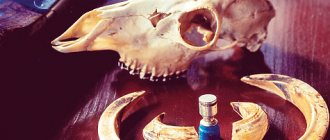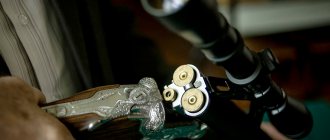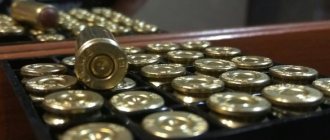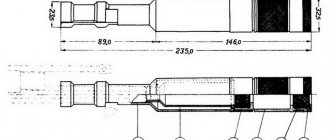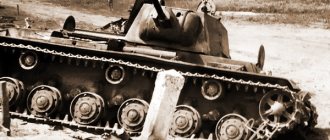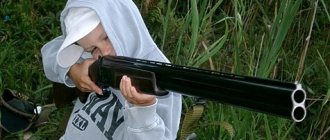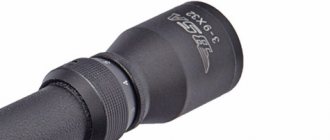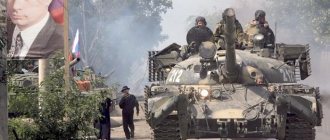Story
| This section is not completed. You will help the project by correcting and expanding it. |
Initially, all firearms, both hand and heavy (artillery), were smooth-bore. The mass introduction of rifled weapons in armies began only in the second half of the 19th century, when, on the one hand, the improvement of technology made it possible to establish mass production of cheap rifled barrels, on the other hand, it became possible to quickly reload such weapons from the muzzle thanks to the advent of self-expanding bullets when fired, although for hunting and target shooting, it was widely used long before that.
Suvorov’s aphorism “The bullet is stupid, the bayonet is great” refers specifically to smooth-bore weapons. Accuracy and range of smoothbore rifles of the late 18th - early 19th centuries. can be shown using the example of a Russian infantry 7-line (17.78 mm) rifle of the 1808 model: with a barrel length of about 1140 mm, an average of 75% of the bullets hit a target measuring 1.8 × 1.22 m from a distance of 100 steps , 200 steps - 50%, 300 steps - 25%.[2]
Hand-held smoothbore weapons
Currently, it is used mainly for hunting and as a service weapon (shotguns), as well as for self-defense (shotguns and simple smooth-bore pistols).
The barrel of a gun can have either equal or different diameters at the beginning and end. There is a term - muzzle constriction. For smoothbore guns it can be constant or variable.
If the diameters of the barrel at the beginning and at the end are different (the diameter at the exit from the barrel is smaller), then it is impossible to shoot a caliber bullet from it - it will simply get stuck (or rather, the barrel will inflate). To fire a bullet, it is necessary that it pass through the muzzle narrowing with a gap of about 0.3-0.5 mm (sub-caliber bullet) or have crushable driving belts. The muzzle constriction (reinforced choke 1.25 mm) is necessary to increase accuracy when shooting at extreme distances with shot No. 6 and No. 7. Some guns have interchangeable attachments; chokes, chokes, cylinders screwed into the bore (typical for pump-action and self-loading smoothbore shotguns). However, it should be remembered that there is no universal weapon.
A straight barrel (cylinder) is designed for firing a caliber bullet and has decent accuracy when shooting buckshot, but has worse accuracy when shooting with shot at a distance of more than 20-30 meters.
For a long time, the development of bullets for smooth-bore hand-held weapons, similar to the feathered projectiles widely used in modern smooth-bore artillery, has been ongoing, which in theory would make it possible to bring or at least bring the accuracy of smooth-bore weapons closer to those of rifled weapons; Meanwhile, to date they have not led to the creation of a sample suitable for mass production. One of the significant reasons for this is the difficulty and high cost of ensuring the constancy of the shape and size of such small, compared to projectiles, striking elements during their mass production.
Classes
Smoothbore guns are divided into classes depending on:
- number of barrels (1, 2 or 3 (combined with a rifled barrel));
- the presence or absence of a magazine and its type (under-barrel tubular, box-shaped);
- reloading method (barrel fracture, swinging fore-end (pump-action), self-loading (“semi-automatic”), bolt-action (rifle) bolt.
- Different calibers of smooth-bore weapons mean different masses of the cartridge, mass of the shot (bullet) charge, and mass of gunpowder. There are guns from 4 to 32 calibers, expressed in fractions of a pound: 4, 8, 10, 12, 16, 20, 22, 24, 28, 32 (the numbers indicate the number of bullets of a given caliber cast from a lead ingot weighing 1 pound) and .410 caliber, expressed in fractions of an inch. Accordingly, the larger the caliber number, the smaller the diameter of the cartridge case, the charge of gunpowder, shot (bullet) and recoil. The amount of recoil depends on the weight of the weapon (more weight of the weapon, less recoil), the weight of the striking part (more weight, greater recoil), the type of striking part (shot - less recoil, bullet - more recoil) all other things being equal, the weapon reloading system ( gas exhaust system reduces recoil). It should be noted that a distinctive feature of smooth-bore weapons is also the length of the chamber (65,70,76 or 89 mm).
What is a smoothbore weapon?
An important nuance for a beginner is that a smooth-bore weapon is usually called a gun (or shotgun), but if we are talking about a rifle or carbine, it means a rifled weapon.
Main characteristics of smoothbore weapons:
- Simplicity of design and reliability
- Ability to use different types of ammunition (shot, buckshot, bullet)
- Great stopping power at close ranges
It is purchased for hunting birds, large animals, and for bench or practical shooting.
Each type of weapon is assigned different tasks, which is reflected in the appearance and tactical and technical characteristics of the units. What unites the entire smoothbore series is the following:
- effective firing range of shot shells is 35–50 m; The effective firing range of bullet ammunition is approximately 100 m.
- use of shot, bullet, grapeshot, traumatic ammunition
Also, all types of smoothbore guns are characterized by high performance at close ranges, due to the high energy of the ammunition and stopping effect.
When choosing hunting rifles, you need to pay attention first of all to the tasks that you set for the gun; Next, determine the caliber that suits your needs; and in the end, choose a gun that is suitable in terms of quality and ergonomics.
Important performance characteristics:
- ease of maintenance - pump-action and inertia shotguns are favorites here;
- recoil absorption mechanisms - the lower the recoil, the more comfortable the shooting;
- barrel reliability, its drilling and technologies that affect sharpness and scree;
- convenience of the reloading mechanism;
- ease of use and safety.
Shotguns are divided into types depending on their design features.
Turning point
– double-barreled shotguns with vertical or horizontal barrels. These guns do not have a magazine; the cartridge is placed directly into the chamber, the length of which determines the choice of suitable ammunition.
Self-loading
(or semi-automatic) - single-barreled shotguns with an under-barrel magazine. In turn, they are divided into inertial and gas-operated, depending on the design of the reloading mechanism. These are rapid-fire guns that allow you to fire several shots in a row, the number of which is limited only by the magazine capacity.
Pump-action
– single-barreled shotguns with an under-barrel magazine. To reload a pump-action shotgun, after each shot it is necessary to set in motion the fore-end sliding along the under-barrel magazine, after which the spent cartridge is ejected and the next cartridge is chambered.
Smoothbore artillery
Since the introduction of rifled barrels into artillery, light portable systems—mortars and grenade launchers—have remained smoothbore. Their projectiles are stabilized by an aerodynamic tail, either permanent or (less commonly) deployable.
A “return” to smooth-bore guns occurred in tank building. With the advent of feathered shells, smoothbore guns acquired the following advantages over rifled ones:
- In a smoothbore gun, it is possible to significantly (1.5-2 times) increase the pressure in the barrel bore without the risk of “washing out” the rifling, and therefore increase the initial velocity of the projectile.
- The armor penetration of sub-caliber projectiles is increasing.
- There is no need to use solutions to compensate for projectile rotation in cumulative projectiles (projectile rotation has a negative effect on the formation of a cumulative jet).
- It is becoming easier to manufacture an ATGM launched through the bore.
All this has led to the fact that most modern and future tanks are equipped with smoothbore guns.
It is worth noting that modern smoothbore guns are generally less accurate, especially at distances exceeding the range of a direct shot. In addition, due to the presence of a HE stabilizer system, tank gun shells are less effective compared to rifled artillery of the same caliber.
Technical progress in the fate of smoothbore weapons
In our time, in the era of the dominance of rifled firearms in the military field, smooth-bore weapons have taken root well in the civilian sphere. Today this type of firearms is represented quite widely. This type includes:
- smooth-bore double-barreled and single-barreled shotguns;
- pump-action shotguns;
- self-loading models;
- revolver type guns;
- shotguns.
If the first of these types are used more for commercial and applied purposes, then the latter option has become a favorite weapon of police and paramilitary forces.
Despite the fact that the smoothbore gun is technologically one of the most ancient designs, technological progress has not ignored this design. The main advantage that a smooth barrel has over rifled barrels is a larger caliber and the ability to use not one, but several striking elements for shooting. Fire from a musket or arquebus was not highly accurate. The probability of hitting the target with a single bullet was extremely low, this was especially true as the combat distance increased.
Firing, which was carried out with several projectiles at once, had a great damaging effect. First of all, the artillerymen were able to appreciate this advantage. Shooting grapeshot was a favorite defensive technique against charging cavalry and advancing infantry. The dispersion of shells increased the affected area at a short distance. One, two, three fired buckshots could find their targets. This capability compensated for the lack of aiming, especially in situations where it was necessary to fire at close ranges and at high intensity.
Buck shot
For infantry units, where the main tactical technique is increased combat distance, smoothbore rifles and pistols continue to fire bullets. Even in the absence of rifling in the bore, a bullet fired from the barrel of a smoothbore weapon flies further and hits harder. Buckshot and buckshot are becoming favorite shells in the hunters' arsenal. Equally important is the versatility of this type of firearm. The shooter can always use his weapon to shoot either shot or use a caliber bullet. This quality was appreciated by hunters who hunt small game and large animals at the same time.
As they improve, weapons technology becomes more and more progressive. Gunsmiths are working with new steel samples, the quality of barrel bore processing is improving, and the design of products is improving. The trigger mechanism goes through all stages of its development, from the wick and silicon devices to the impact-capsule device.
Trigger-capsule mechanism
Loaded through the barrel of a gun, they receive a new loading mechanism - by breaking it, or using a magazine. All this leads to the fact that the ancient type of weapons becomes adapted to modern conditions.
Excerpt characterizing smoothbore weapons
The crowd moved again. Nesvitsky realized that it was the core. - Hey, Cossack, give me the horse! - he said. - Well you! stay away! step aside! way! With great effort he reached the horse. Still screaming, he moved forward. The soldiers squeezed to give him way, but again they pressed on him again so that they crushed his leg, and those closest were not to blame, because they were pressed even harder. - Nesvitsky! Nesvitsky! You, madam! – a hoarse voice was heard from behind. Nesvitsky looked around and saw, fifteen paces away, separated from him by a living mass of moving infantry, red, black, shaggy, with a cap on the back of his head and a brave mantle draped over his shoulder, Vaska Denisov. “Tell them, the devils, to give the dog,” he shouted. Denisov, apparently in a fit of ardor, shining and moving his coal-black eyes with inflamed whites and waving his unsheathed saber, which he held with a bare little hand as red as his face. - Eh! Vasya! – Nesvitsky answered joyfully. - What are you talking about? “Eskadg’on can’t leave,” shouted Vaska Denisov, angrily opening his white teeth, spurring his beautiful black, bloody Bedouin, who, blinking his ears from the bayonets he bumped into, snorting, spraying foam from the mouthpiece around him, ringing, he beat his hooves on the boards of the bridge and seemed ready to jump over the railings of the bridge if the rider would allow him. - What is this? like bugs! exactly the same as the bugs! Pg'och... give the dog!... Stay there! you're a cart, why not! I'll kill you with a saber! - he shouted, actually taking out his saber and starting to wave it. The soldiers with frightened faces pressed against each other, and Denisov joined Nesvitsky. - Why aren’t you drunk today? - Nesvitsky said to Denisov when he drove up to him. “And they won’t let you get drunk!” - answered Vaska Denisov. “They drag the regiment here and there all day long.” Dg'atsya - so dg'atsya. Otherwise he doesn’t know what it is! - What a dandy you are today! – Nesvitsky said, looking at his new mantle and saddle pad. Denisov smiled, took out a handkerchief from his bag, which smelled of perfume, and stuck it in Nesvitsky’s nose. - I can’t, I’m going to work! I washed myself, brushed my teeth and put on perfume. The dignified figure of Nesvitsky, accompanied by a Cossack, and the determination of Denisov, waving his saber and shouting desperately, had such an effect that they squeezed onto the other side of the bridge and stopped the infantry. Nesvitsky found a colonel at the exit, to whom he needed to convey the order, and, having fulfilled his instructions, went back. Having cleared the road, Denisov stopped at the entrance to the bridge. Casually holding back the stallion rushing towards his own and kicking, he looked at the squadron moving towards him. Transparent sounds of hooves were heard along the boards of the bridge, as if several horses were galloping, and the squadron, with officers in front, four in a row, stretched out along the bridge and began to emerge on the other side. The stopped infantry soldiers, crowding in the trampled mud near the bridge, looked at the clean, dapper hussars marching orderly past them with that special unfriendly feeling of alienation and ridicule with which various branches of the army are usually encountered. - Smart guys! If only it were on Podnovinskoye! - What good are they? They only drive for show! - said another. - Infantry, don't dust! - the hussar joked, under which the horse, playing, splashed mud at the infantryman. “If I had driven you through two marches with your backpack, the laces would have been worn out,” the infantryman said, wiping the dirt from his face with his sleeve; - otherwise it’s not a person, but a bird sitting! “If only I could put you on a horse, Zikin, if you were agile,” the corporal joked about the thin soldier, bent over from the weight of his backpack. “Take the club between your legs, and you’ll have a horse,” responded the hussar. The rest of the infantry hurried across the bridge, forming a funnel at the entrance. Finally, all the carts passed, the crush became less, and the last battalion entered the bridge. Only the hussars of Denisov's squadron remained on the other side of the bridge against the enemy. The enemy, visible in the distance from the opposite mountain, from below, from the bridge, was not yet visible, since from the hollow along which the river flowed, the horizon ended at the opposite elevation no more than half a mile away. Ahead there was a desert, along which here and there groups of our traveling Cossacks were moving. Suddenly, on the opposite hill of the road, troops in blue hoods and artillery appeared. They were French. The Cossack patrol trotted away downhill. All the officers and men of Denisov’s squadron, although they tried to talk about outsiders and look around, did not stop thinking only about what was there on the mountain, and constantly peered at the spots on the horizon, which they recognized as enemy troops. The weather cleared again in the afternoon, the sun set brightly over the Danube and the dark mountains surrounding it. It was quiet, and from that mountain the sounds of horns and screams of the enemy could occasionally be heard. There was no one between the squadron and the enemies, except for small patrols. An empty space, three hundred fathoms, separated them from him. The enemy stopped shooting, and the more clearly one felt that strict, menacing, impregnable and elusive line that separates the two enemy troops. “One step beyond this line, reminiscent of the line separating the living from the dead, and - the unknown of suffering and death. And what's there? who's there? there, beyond this field, and the tree, and the roof illuminated by the sun? Nobody knows, and I want to know; and it’s scary to cross this line, and you want to cross it; and you know that sooner or later you will have to cross it and find out what is there on the other side of the line, just as it is inevitable to find out what is there on the other side of death. And he himself is strong, healthy, cheerful and irritated, and surrounded by such healthy and irritably animated people.” So, even if he doesn’t think, every person who is in sight of the enemy feels it, and this feeling gives a special shine and joyful sharpness of impressions to everything that happens in these minutes. The smoke of a shot appeared on the enemy’s hill, and the cannonball, whistling, flew over the heads of the hussar squadron. The officers standing together went to their places. The hussars carefully began to straighten out their horses. Everything in the squadron fell silent. Everyone looked ahead at the enemy and at the squadron commander, waiting for a command. Another, third cannonball flew by. It is obvious that they were shooting at the hussars; but the cannonball, whistling evenly quickly, flew over the heads of the hussars and struck somewhere behind. The hussars did not look back, but at every sound of a flying cannonball, as if on command, the entire squadron with their monotonously varied faces, holding their breath while the cannonball flew, rose in their stirrups and fell again. The soldiers, without turning their heads, glanced sideways at each other, curiously looking for the impression of their comrade. On every face, from Denisov to the bugler, one common feature of struggle, irritation and excitement appeared near the lips and chin. The sergeant frowned, looking around at the soldiers, as if threatening punishment. Junker Mironov bent down with each pass of the cannonball. Rostov, standing on the left flank on his leg-touched but visible Grachik, had the happy look of a student summoned before a large audience to an exam in which he was confident that he would excel. He looked clearly and brightly at everyone, as if asking them to pay attention to how calmly he stood under the cannonballs. But in his face, too, the same feature of something new and stern, against his will, appeared near his mouth.
How to choose a smoothbore weapon for hunting?
The choice of hunting weapon for every hunter is a very important moment. Depending on how correctly the choice was made, this or that model can serve its owner for a very long time, or, on the contrary, turn out to be absolutely inconvenient and ineffective to use.
Things to consider when choosing a gun:
- The selected model should be as convenient as possible both for shooting and for transportation. In the circle of hunters there is even a special term “butt”. It means that after the hunter raises his weapon, aiming (that is, combining his own gaze with the aiming bar and front sight) should be carried out as quickly as possible and without unnecessary discomfort. Thanks to this quality, the gun allows you to accurately hit the target when shooting offhand.
- Gun balance. Balance also has a significant impact on the degree of comfort while shooting. If the center of gravity in the weapon is closer to the shooter, then aiming and shooting will be much more convenient.
- Appearance. Obviously, the selected single-barreled weapon should not have any damage, cracks, gouges, or scratches, so that repairs do not have to be made later. It is especially important to pay attention to sighting devices. The bar must be securely attached to the weapon. The test can be done using a small metal stick. If there is a rattling sound, you should choose another copy, since it is obvious that in this model the aiming bar will not allow accurate shooting.
- Structural strength. In this case, you should pay attention to how well the barrels are attached, especially when it comes to breaking types of guns. You can check it as follows: you need to disconnect the forend, place the weapon with the butt towards you and put your finger on the place where the barrel connects to the body. Next you need to make swinging movements. If the trunk is poorly attached, it will be felt.
- The trunks should also be checked from the inside. They must be clean and free of grease. If there is grease, it is recommended to ask the seller to remove it. If you choose a double-barreled shotgun, you should inspect the shadow rings from the inside - circles that are located at the same distance from each other. The rings must have the correct rounded shape. The presence of bends or deformations indicates that the barrel is defective. In such cases, you should not hope for subsequent repairs; it is better to immediately refuse to purchase such a model.
- It is important to pay attention to the muzzle. It should be placed perpendicular to the axis of the barrel, without minimal deviations. The slightest discrepancy leads to significant deviations in the bullet’s flight path, which in turn reduces accuracy. This is true for both single-barreled and double-barreled shotguns.
- Equipment. Having tools for repairs, as well as special packaging for transporting firearms, is mandatory.
In order to choose the best smoothbore weapon, be it an Italian gun or a domestic product, you must take into account all the factors described above. The choice of a smoothbore gun should also be based on your preferences and wishes, as well as existing experience. Both single-barreled and double-barreled firearms are quite effective during hunting, especially if you follow the basic rules, shooting techniques, and also undergo special training.

